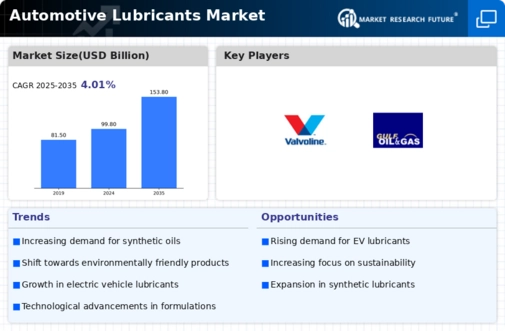Increasing Vehicle Production
The Automotive Lubricants Market is significantly influenced by the rising production of vehicles across various segments. As economies recover and consumer demand for personal and commercial vehicles increases, the need for lubricants is expected to grow correspondingly. In 2025, the production of passenger cars is projected to reach approximately 80 million units, which will inherently drive the demand for automotive lubricants. This trend is further supported by the expansion of automotive manufacturing facilities in emerging markets, where the demand for vehicles is surging. Consequently, the Automotive Lubricants Market is poised for growth as manufacturers seek to provide high-quality lubricants that cater to the needs of a diverse range of vehicles.
Growth of Aftermarket Services
The Automotive Lubricants Market is benefiting from the expansion of aftermarket services, which play a crucial role in maintaining vehicle performance. As vehicle owners become more aware of the importance of regular maintenance, the demand for high-quality lubricants in the aftermarket segment is on the rise. In 2025, the aftermarket for automotive lubricants is expected to account for a significant share of the overall market, driven by factors such as increased vehicle age and the growing trend of DIY maintenance. This shift presents opportunities for lubricant manufacturers to develop targeted marketing strategies and product offerings that cater to the specific needs of consumers in the aftermarket. Consequently, the Automotive Lubricants Market is likely to see a robust growth trajectory as it adapts to the evolving preferences of vehicle owners.
Technological Advancements in Lubricants
The Automotive Lubricants Market is experiencing a notable shift due to rapid technological advancements. Innovations in lubricant formulations, such as synthetic and semi-synthetic oils, are enhancing performance and efficiency. These advancements are driven by the need for improved fuel economy and reduced emissions, which are critical in today's automotive landscape. For instance, the introduction of low-viscosity oils has been shown to improve fuel efficiency by up to 5%. Furthermore, the integration of nanotechnology in lubricants is expected to enhance their properties, leading to longer service intervals and better engine protection. As manufacturers continue to invest in research and development, the Automotive Lubricants Market is likely to witness a surge in demand for high-performance lubricants that meet stringent regulatory standards.
Emergence of Electric and Hybrid Vehicles
The Automotive Lubricants Market is undergoing transformation with the emergence of electric and hybrid vehicles. While these vehicles require different lubrication solutions compared to traditional internal combustion engines, the overall demand for lubricants remains robust. Electric vehicles, for instance, utilize specialized lubricants for their drivetrains and cooling systems, which presents new opportunities for lubricant manufacturers. As the market for electric and hybrid vehicles expands, projected to reach over 30 million units by 2030, the Automotive Lubricants Market must adapt to these changes by developing innovative products that cater to the unique requirements of these vehicles. This shift not only diversifies the product offerings but also encourages research into new lubricant technologies that enhance the performance and longevity of electric and hybrid vehicles.
Regulatory Compliance and Environmental Standards
The Automotive Lubricants Market is increasingly shaped by stringent regulatory compliance and environmental standards. Governments worldwide are implementing regulations aimed at reducing emissions and promoting sustainability, which directly impacts lubricant formulations. For example, the introduction of the API SN and ILSAC GF-5 standards has necessitated the development of low-emission lubricants that enhance engine performance while minimizing environmental impact. As a result, lubricant manufacturers are compelled to innovate and adapt their products to meet these evolving standards. This regulatory landscape not only drives the demand for advanced lubricants but also encourages the Automotive Lubricants Market to invest in sustainable practices and eco-friendly formulations, thereby aligning with global sustainability goals.


















Leave a Comment